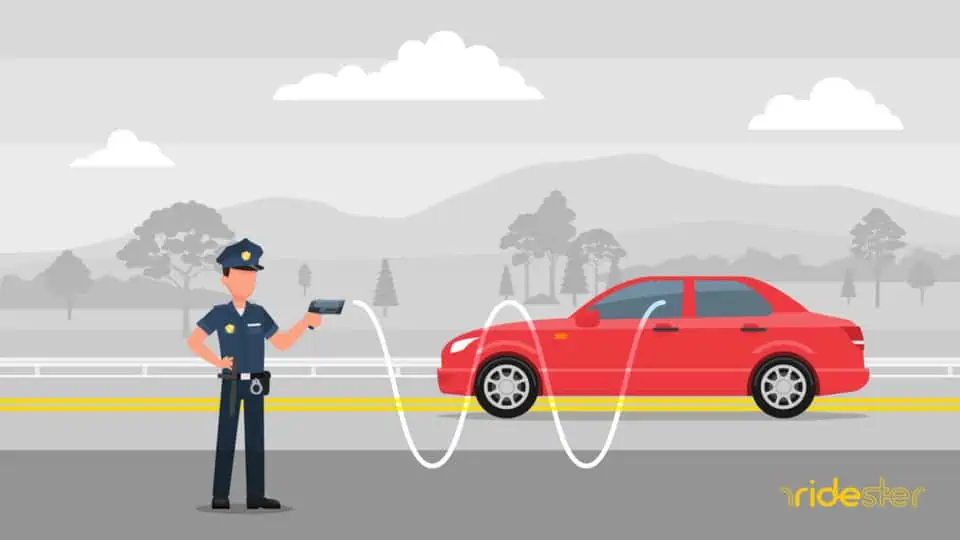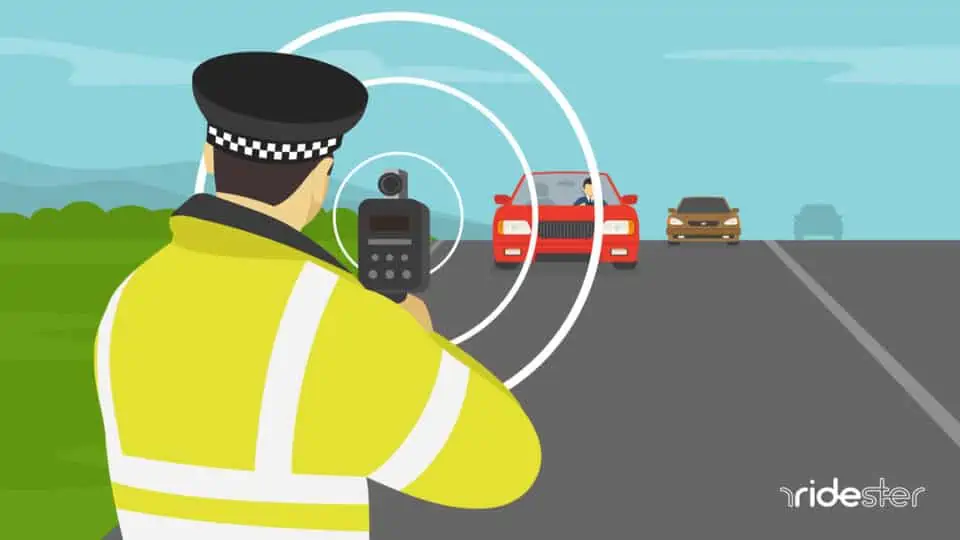Radar is a technology that was originally devleoped to detect different objects in the atmosphere, yet there are many different kinds of radar used today.
One of these use cases includes commercially-available radar detectors. When purchasing one, however, is essential to learn about the difference between the KA band vs X band to choose a the most suitable option for you.
If you’re interested in learning more about how a radar detector works, what radar waves are, what a frequency band is, and how KA and X bands work, read on.
How Do Radar Detectors Work?
To understand this concept, you must first understand frequency and wavelengths.
- Frequency describes the number of waves that pass a fixed place in a given amount of time. For example, if a wave takes 0.5 seconds to pass through an area, the frequency is 2 per second.
- Wavelengths are the distance between identical points in the adjacent cycles of a waveform signal propagated in space.
The wavelength and frequency of a wave are inversely proportional. The higher the frequency, the shorter the wavelength.
The amount of space between the waves will be shorter if a frequency is higher (meaning it moves faster).
When a police officer detects the change in frequency of the reflected wave off of a vehicle with a radar detector, he can determine the approximate speed of the vehicle.
An Example to Help Explain
Although it may seem intimidating at first, it is easy to understand how a radar detector works.
First, it is best to start with understanding how police radars work as it is the easiest to visualize.
As most have experienced, police officers will station their cars with their radar detectors positioned at specific points on roads or highways that are likely to experience excessive speeding.
Radars send a signal out and wait to receive it. Any changes in the signal’s frequency communicate a specific speed of whatever the radar was aimed at, which happens thanks to the Doppler shift.
The Doppler shift is the change in a wave’s frequency as it relates to the observer, who moves relative to that wave source.
These radars are used by law enforcement to notify them of any vehicle that passes in front of the radar traveling at speeds faster than the set speed limit.
They can be operated manually in police cars or automatically when they are set up on road signs or traffic lights.
Radar detectors work by detecting those specific signals that exist with a frequency band. Then, the radar detector notifies the user.
However, police change their frequency range often, which means it’s usually necessary to update your radar detector often, as well.
A radar detector can also fail if an officer has their radar off until it is being actively used.
In this case, a radar detector only notices the signal once it is too late.
Explaining Radar Waves
To understand the workings of radar detectors and the difference between radar bands, you must understand a radar wave.
A radar wave is a form of electromagnetic radiation between a specific set of frequencies.
A way to understand electromagnetic waves is your radio.
You can tune your radio to a specific frequency. Maybe your station comes in on frequency 91.5 or maybe on 103.6.
A radar detector operates the same, but with waves on different frequencies than your radio; FM and AM. KA and X Bands may sound like the names of your two favorite radio stations.
Instead of picking up music, they detect the signal from a law enforcement vehicle. If it detects a police car, your detector will notify you that law enforcement is near.
KA Band vs X Band: A Primer
Before we dive too deep into the KA band vs X band comparison, let’s go over a few basics.

What is KA Band Radar?
KA band was introduced in the early 2010s and continues to be tested under different circumstances today.
It was introduced with the hope that it would help facilitate communication since other bandwidths were crowded with communications.
The KA Band has a frequency range from 27 GHz to 40 GHz and a wavelength of 5.0 mm to 11.3 mm.
The KA Band Radar vs. the X Band has short wavelengths, which result in high-resolution.
This high resolution makes it great to use for close-range radars.
Frequency Letter Band | KA-Band |
Frequency Range | 27 GHz to 40 GHz |
Wavelength | 5.0 mm to 11.3 mm |
KA Band radar is the newest radar band in use and almost always indicates the presence of a police officer.
A big problem for the KA Band is signal loss due to humidity and rain, as water vapor does not resonate at this frequency.
- Eighty-four percent of North American radar operate on the KA Band
- KA Band operates on as many as five frequencies
- KA Band is the most advanced and up-to-date police radar
- KA Band alerts are the least likely to be false alarms.
The military also uses KA Band frequency aboard military airplanes.
The close-range, high resolution gives an advantage for fewer mistakes.
What is X Band Radar?
X band was introduced in the mid-1940s. However, the first human-made object didn’t make it to space until 1949.
Initially, people only used X-band for communication on earth. Now it’s used for radar, satellite communication, and wireless computer networks (like wi-fi).
It is used most famously for communication with the Mars Reconnaissance Orbiter. Law enforcement often uses x band radars for traffic control and military institutions.
X Band radar has a frequency range from 8.0 GHz to 12 GHz and a wavelength of 3.75 to 2.5 cm.
The longer wavelengths of X Band radar make it have less resolution.
These longer wavelengths do give an advantage to X Band radar, though.
These wavelengths allow the X Band to detect frequencies from a long distance away.
Frequency Letter Band | X Band |
Frequency Range | 8.0 GHz to 12.0 GHz |
Wavelength | 2.5 cm to 3.75 cm |
Law enforcement X Band radar guns operate at 10.5 GHz. X Band radar is the oldest type of licensed police radar frequency.
Because of the low resolution, it is not widely used anymore.
It is not recommended to take off the X Band from your radar detector because it is still used in rural areas or areas without funding for modern radar guns.
- X Band can reach farther distances
- X Band is less affected by inclement weather
- Antennas for X Band must be large
- X Band radars can be bulky and hard to use
- False alerts can happen while using X Band radar.
Although not as widely used in modern radar detectors, the X Band has its advantages.
Most recommend KA Band detectors, but X Band is popular in rural areas.
What’s the Difference Between K Band and KA Band?

KA Band is more complex than both X and K bands. It is comprised of radar waves between 27.0 GHz and 40.0 GHz.
KA Band guns operate on as many as five frequencies. X and K band police radar guns operate on just one or two frequencies.
Some people can get confused about the KA Band and K band.
K band is a chunk of radar frequency that ranges from 18 GHz to 27 GHz and a wavelength range from 1.67 cm to 1.11 cm.
K Band | KA Band | |
Frequency | 18-27 GHz | 27-40 GHz |
Wavelength | 1.67-1.11 cm | 5.0-11.3 mm |
Use | Residential | Law Enforcement |
K band was adopted a couple of decades ago as a high-performance upgrade from X Band radar.
Because of its higher frequency, it is harder to detect from a long-distance than the X Band.
While there is still some use in law enforcement, K band is typically used in residential operations such as automatic door openers and blind-spot monitoring systems in some vehicles.
Is It Legal To Use a Radar Detector?
The legality of radar detectors in the United States differs from state to state.
In 49 states, it is legal to have a radar detector in private vehicles under the Communications Act of 1934 but illegal in commercial vehicles.
In some states/areas, radar detectors are illegal in all vehicles:
- Virginia
- Washington D.C.
- All U.S. military bases
Other restrictions on radar detectors in Minnesota and California deal with them obstructing your windshield view on the highway.
Read More: Are radar detectors legal?
Wrapping Up
KA Band is widely used in modern law enforcement due to its high resolution.
X Band has been phased out but is still prevalent in rural areas.
KA Band is short-range, while the X Band can be detected from further away.
Typically, the KA Band is preferred over the X Band.
KA Band operates at a frequency of 27-40 GHz.
X Band operates at a frequency of 8-12 GHz.
When looking for a radar detector, pick the best fit for your area and weather conditions.
Remember that the X Band works better for inclement weather but is not as widely used anymore.





